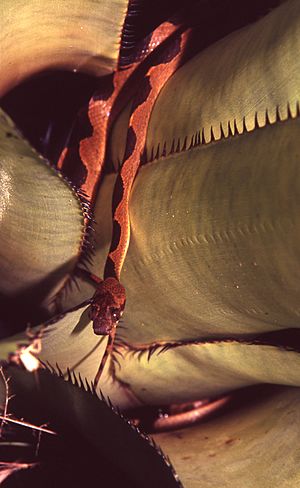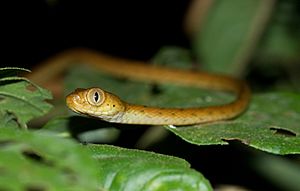Leptodeira annulata facts for kids
Quick facts for kids Leptodeira annulata |
|
|---|---|
 |
|
| Undulous dorsal stripe | |
 |
|
| Vertically elliptic pupil | |
| Conservation status | |
| Scientific classification | |
| Genus: |
Leptodeira
|
| Species: |
annulata
|
| Synonyms | |
The banded cat-eyed snake (Leptodeira annulata) is a type of snake found in the New World. It has a mild venom and is part of the colubrid snake family.
Contents
Other Names for This Snake
People call the banded cat-eyed snake by many names. Some of these include:
- cat-eyed night snake
- come sapo
- culebra de pantano
- culebra destenida
- machete savane
- mapana de agua
- mapana tigre
- ranera
Where Does It Live?
You can find this snake in Mexico, Central America, and South America. It also lives on islands like Margarita and Trinidad and Tobago.
What Does It Look Like?
Adult banded cat-eyed snakes are usually about 750 mm (30 inches) long. They are very thin. Their head is easy to tell apart from their neck. They have large eyes with pupils that look like a vertical slit, similar to a cat's eye.
Their back is yellowish or brown. It has dark brown or blackish spots. These spots often connect to form a wavy or zigzag stripe.
About Its Venom
The banded cat-eyed snake has a pair of special teeth at the back of its upper jaw. These teeth have grooves and deliver a mild venom. This venom helps the snake catch its food, which is mostly small frogs and lizards.
This snake usually does not bite humans when it is handled. If it does bite, the venom has only small effects on most people. Some describe it as a slight itch or irritation with a little swelling. This snake is not considered dangerous to people's health.
Where Does It Like to Live?
This snake prefers moist places. It often lives in forests, both wet and dry. You can also find it near the edges of forests, including green areas in towns close to woods. They are often found near rivers, swamps, and marshes.
How Does It Behave?
The banded cat-eyed snake is a night animal. This means it is active and hunts for food when it is dark. It hunts and eats both in trees and on the ground.
What Does It Eat?
This snake eats many different things. Its diet includes frogs, frog eggs, tadpoles, and salamanders. It also preys on small reptiles like lizards (including anoles) and even smaller snakes. Sometimes, it eats fish or young birds that have just left the nest.
Reproduction and Life Cycle
Snakes in the Leptodeira group lay eggs. This is called being oviparous. Sometimes, the female snake can store sperm and fertilize her eggs later. Eggs of these snakes have been found in the special fungus gardens of Acromyrmex and Atta colombica ants.
See also
 In Spanish: Falsa mapanare para niños
In Spanish: Falsa mapanare para niños


